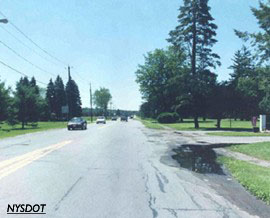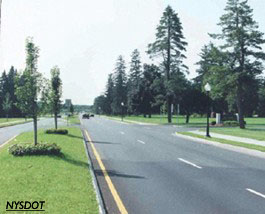A safe and efficient transportation system is a key component of an area's quality-of-life. It has direct bearing on mobility and the accessibility of people and goods to employment, shopping, and other destinations; and affects overall regional development patterns and economic development. In many respects, the Genesee-Finger Lakes Region's transportation system provides a comparative advantage over many other areas in the state and nation. Access management is one means to help protect and enhance the region's competitive advantage in transportation.
What is Access Management?
Access Management is a set of strategies to improve the safety and efficiency of traffic by reducing congestion and decreasing the number of accidents while simultaneously preserving community character through land use planning and site design. Key elements of Access Management include (available in PDF):
- Interconnected street network, including rear access roads and through streets
- Connections between adjacent properties (also known as "cross access")
- Limited driveway openings, including driveway spacing standards
- Shared driveways
- Safe and efficient driveway design
- Corner clearance standards
- Intersection spacing and traffic signal spacing
- Center medians and other means of restricting turns to specific locations
- Shared parking between adjacent businesses, centralized public parking; and side and rear parking (versus parking between roadway and building)
- Convenient internal circulation and connections for motorists, bicyclists, and pedestrians
The key factor to successfully implementing access management strategies is the development of partnerships between the transportation agencies that build, operate, and maintain streets and highways, and the local communities that make planning, zoning, and development decisions.
Benefits of Access Management
An effective local access management program can play an important role in reducing accidents, preserving highway capacity, and avoiding or minimizing costly roadway improvements to correct safety and congestion problems:
- The traveling public benefits from safer and more efficient travel, including pedestrians and bicyclists;
- Land and surrounding infrastructure are often more efficiently utilized when access management tools are applied to property development and redevelopment;
- Many businesses benefit from increased economic vitality along a well-managed corridor because of easier access to and from their establishments;
- Reduced congestion can reduce fuel consumption and air quality impacts related to traffic delays as well as save time;
- Taxpayers benefit from the more efficient use of existing transportation facilities. By improving the safety and efficiency of existing highways, a community or agencys limited resources can be utilized elsewhere. Likewise, many access management strategies are relatively low in cost to implement.
Access management does more than improve the safety and efficiency of travel. Well-designed access systems can also help preserve community character, advance economic development goals, and protect the substantial public investment in roads and highways. As state and local governments strive to cope with traffic problems, limited rights-of-way, rising construction costs, and revenue shortfalls, increasingly they are recognizing the benefits of access management.
Corridor Aesthetics
The application of Access Management principles and techniques may also provide opportunities to enhance a corridors aesthetics. Access management projects often involve widening existing roadways to add an additional two-way-left-turn lane (TWLTL) or a raised median. Such projects could lead to a wide expanse of concrete and asphalt. Unique aesthetic treatments can and should be incorporated into access management project plans in an effort to enhance the attractiveness as well as the safety and efficiency of a corridor.
Moreover, access management projects are much more likely to be accepted by the public and by business owners of adjacent properties if they look good as well as improve safety and traffic flow. Some possible aesthetic treatments include:
- Landscaping raised medians, including the addition of gateway treatments
- Adding pavement textures and designs to medians and parking areas
- Adding well designed retaining walls where needed to prevent erosion
- Planting street trees and other vegetation (while maintaining good sight distance)
- Removing signs from the clear zone and otherwise modifying commercial signs to make them less obtrusive
- Adding uniform, well designed street lights and other hardware, including pedestrian amenities like benches, transit shelters, and pedestrian-scale lighting
- Burying utility lines underground to eliminate them from view


Benefits to Pedestrians
Access management is usually promoted as a way to improve driving conditions for motorists. Clearly, access management techniques can lead to roads and streets that are dramatically safer and much easier and more pleasant to drive. However, research also indicates that several key access management techniques are just as valuable to pedestrians. These include:
- Reducing the number of driveways, particularly commercial driveways, within a given distance (per block or mile);
- Providing for greater distance separation between driveway; and
- Providing a safe refuge for pedestrian crossings with raised medians.
- Access Management and Pedestrian Safety
Other Access Management Resources
- Center for Urban Transportation Research (CUTR) Access Management Program
- Access Management: An Overview (Humstone and Campoli)
- Transportation Research Boards Access Management Committee
- Iowa's Access Management Awareness Project
- Minnesota Department of Transportation's Access Management Program
- Transportation Research Board's Access Management Manual (2003)
[Available for purchase through the Transportation Research Board; or available for review at the GTC Offices]